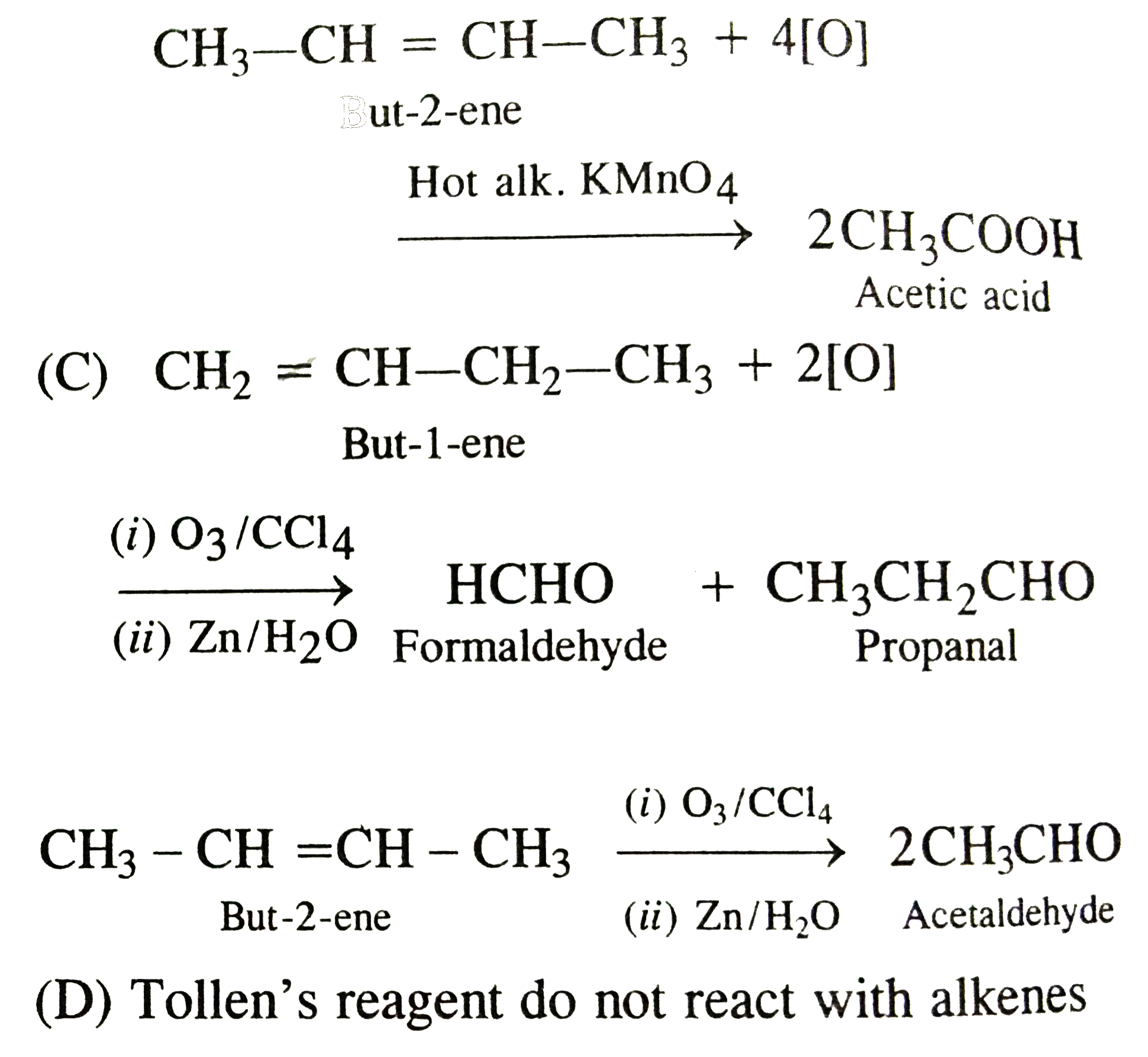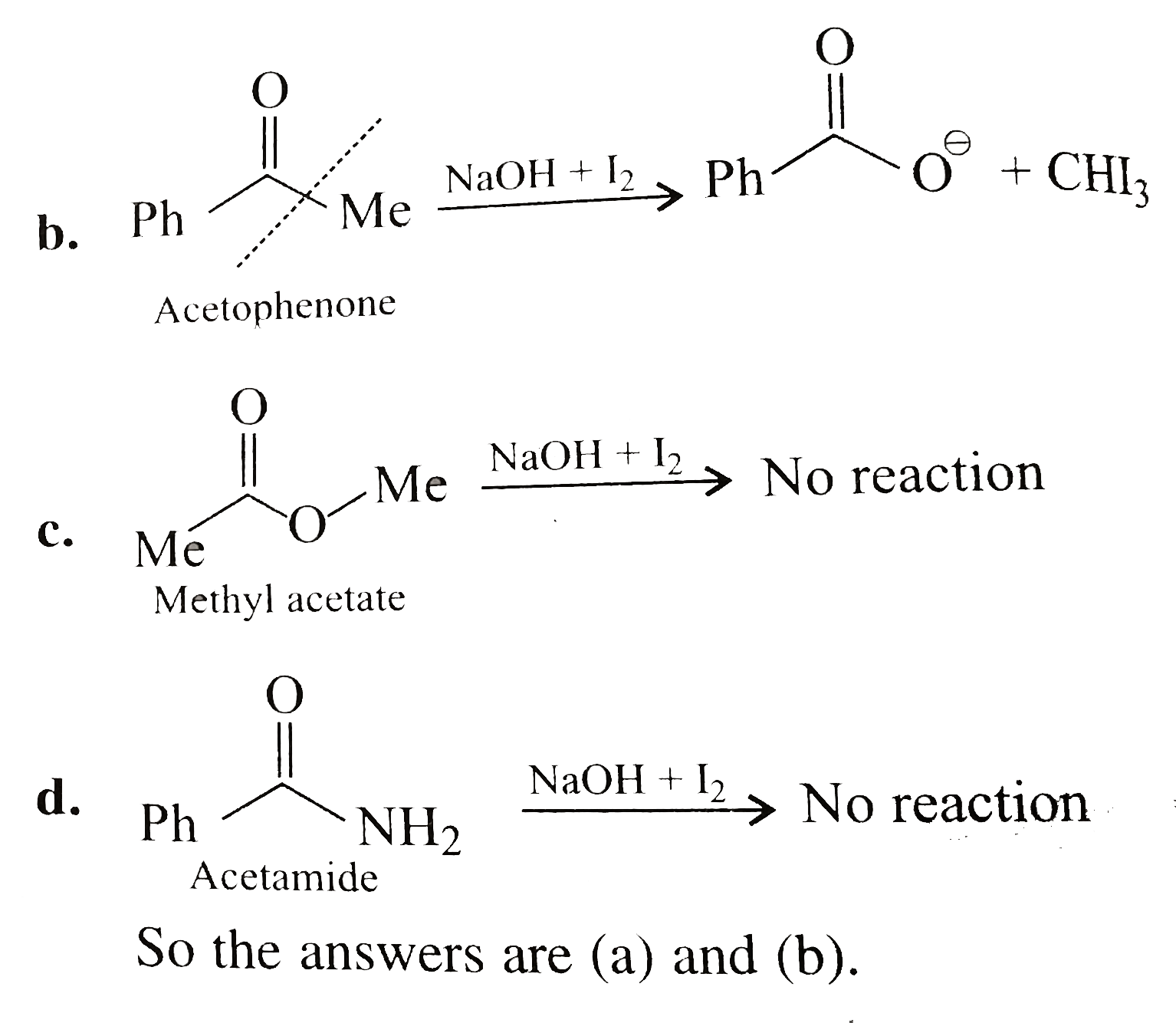InterviewSolution
This section includes InterviewSolutions, each offering curated multiple-choice questions to sharpen your knowledge and support exam preparation. Choose a topic below to get started.
| 2451. |
Which of the following reagents can be used to distinguish the SO_2 and CO_2 ? |
|
Answer» LIME water (C )`5SO_2+2IO_3^(-)+4H_2O to I_2+5SO_4^(2-)+8H^(+) , I_2+` starch `to` blue colour. No colour change observed with `CO_2`. (D)`3SO_2+Cr_2O_7^(2-)+2H^(+)to2Cr^(3+)`(GREEN solution) +`3SO_4^(2-) + H_2O` No colour change is observed with `CO_2` |
|
| 2452. |
Write the IUPAC nomenclature of the given complex along with its hybridization and structure K_(2) [Cr(NO)(NH_(3))(CN)_(4)], mu = 1.73 BM |
| Answer» Solution :Potassium aminetetracyanonitrosoniumchromate (I), OCTAHEDRAL shape Potassiumamminetetracyano(C)nitrosoniumchromium(I) CRIS in + 1 state and `d^(2)SP^(3)` HYBRIDISATION No. of unpaired electron `mu=sqrt( n(n+2)) = sqrt3= 1.73 B.M`. | |
| 2453. |
Which of the following shows maximum diversity? |
|
Answer» water at `25^(@)C` |
|
| 2454. |
Which of the following statement is not correct for [Ni(CN)_(4)]^(2-) and [NiCl_(4)]^(2-) complexes. |
|
Answer» Both have Niin + II oxidationstate. |
|
| 2455. |
Vinyl halides are inert towards both S_(N^(1)) and S_(N^(2)) reactions. Assign reason. |
Answer» SOLUTION :Vinyl halides exhibit resonance. As a result the `C-X` bond has a partial double bond character.  In `S_(N^(1))` reaction, `C-X` the bond is to cleave to FORM a carbocation INTERMEDIATE. IN `S_(N^(2))` reaction. the bond has to again cleave to accommodate the attacking nucleophile. this means that vinyl halides are RELUCTANT to respond to both types of reaction. |
|
| 2456. |
Vapourphasenitration ofalkanetakesplaceat temperature |
| Answer» Solution :Reactioncarriedout in vapourphase | |
| 2457. |
Which of the following is a transition metal ? |
|
Answer» Ca |
|
| 2458. |
The two complexes given below are |
|
Answer» geometrical isomers |
|
| 2459. |
The standard oxidation potentials of two metals M_(1) and M_(2) are 0.76 V and -0.34 Vrespectively. If a rod of metal M_(1) is dipped into an aqueoud solution of metal M_(2) , then the following happens, |
|
Answer» no REACTION TAKES place |
|
| 2460. |
Which among the following has both local anaesthetic and antiseptic properties? |
|
Answer» BENZYL BENZOATE |
|
| 2461. |
Which of the following is the correct order of acidic strength ? |
|
Answer» `Cl_(2)O_(7)gtSO_(3)gtP_(4)O_(10)` |
|
| 2462. |
What is the formula of Triammine triaquachrmium (III) chloride ? |
|
Answer» `[CrCl_(3)][CR(H_(2)O)_(3)]Cl_(3)` |
|
| 2463. |
Which one of the following metals will give blue ash when its salt is heated with Na_(2)CO_(3) solid and Co(NO_(3))_(2) on a charcoal piece |
|
Answer» `CU` |
|
| 2464. |
Which one of the following is an example for heterogeneous catalysis? |
|
Answer» Decomposition of ACETALDEHYDE by `I_(2)`, catalyst |
|
| 2465. |
Which one of the following is not the correct reaction of aryldiazonium salts ? |
|
Answer» `C_(6)H_(5)N_(S)^(+)Cl^(-)+Cu_(2)Cl_(2) rarr C_(6)H_(5)Cl^(-)` |
|
| 2466. |
What happens when NH_4OH solution is added drop by drop to CuSO_4 solution till excess? |
| Answer» Solution :FIRST a bluish white precipitate is formed. When excess of ammonium HYDROXIDE is added a deep BLUE colouration is obtained due to the FORMATION to tetramine copper(II) sulphate complex. | |
| 2467. |
Which of the following forms cationic micelles above certain concentration |
|
Answer» cetyl TRIMETHYL ammonium BROMIDE |
|
| 2468. |
This section contains Three questions. The section contains Two tables (each having 3 columns and 4 rows). Based on each table, there are THREE questions. Each question has FOUR options (A), [B]. [C], and [D]. ONLY ONE of these four options is correct. Answer Q. 1, 2 and 3 by appropriately matching the information given in the three columns of the following table. Q Find CORRECT combination: |
|
Answer» (III) (iii)(P) (according to charge balance in a molecule) 2n + 6 + 24 - 36 = 0 n = 3 |
|
| 2469. |
Which of the folllowing can be used to distinguised between 1-butene and 2-butene? |
|
Answer» Baeyer's reagent (B) `UNDERSET("But-1-ene")(CH_(2)=CH-CH_(2)-CH_(3)+4[O])` `overset("Hot alk." KMnO_(4))rarr CO_(2)+H_(2)O+ underset("Propanoic acid")(CH_(3)CH_(2)COOH)` 
|
|
| 2470. |
The triangleG in the process of melting of ice at - 156@C is: |
|
Answer» `triangleGlt0` |
|
| 2471. |
What will be the value of x, y and z in the following equation. H_(2)C_(2)O_(4)+xH_(2)O_(2)rarryCO_(2)+zH_(2)O |
|
Answer» 2,1,2 `H_(2)C_(2)O_(4)+xH_(2)Orarr yCO_(2)+zH_(2)O` Balancing carbon atoms on both sides, `H_(2)C_(2)O_(4)rarr2CO_(2)` Balancing hydrogen atoms on both sides, `H_(2)C_(2)O_(4)rarr2CO_(2)+2H^(+)` Balancing the charge on both sides, `H_(2)C_(2)O_(4)rarr2CO_(2)+2H^(+)+2e^(-)` (balanced) (ii) The half reaction for REDUCTION is, `H_(2)O_(2)rarrH_(2)O` Balancing oxygen atoms on both sides, `H_(2)O_(2)rarr2H_(2)O` Balancing hydrogen atoms, `H_(2)O_(2)+2H^(+)rarr2H_(2)O` Balancing the charge, `H_(2)O_(2)+2H^(+)+2e^(-)rarr2H_(2)O` (balanced) Now, ADDING both equation, `H_(2)C_(2)O_(4)+H_(2)O_(2)rarr2CO_(2)+2H_(2)O` |
|
| 2472. |
Which of the following has highest nucleophilicity? |
|
Answer» `F^(-)` |
|
| 2473. |
The relationship between the dissociation energy of N_(2) and N_(2)^(+) is |
|
Answer» DISSOCIATION enerty of `N_(2)=` dissociation energy of `N_(2)^(+)` Hence dissociation energy of `N_(2)gt` dissociation energy of `N_(2)^(+)`. |
|
| 2474. |
Which of the following alkyl halide will undergo S_N 1 reaction is |
|
Answer» `(CH_3)_3C-F` |
|
| 2475. |
Which of the following catalyse the chemical reaction in living organism? |
|
Answer» ENZYMES |
|
| 2476. |
The unit of K_(c) from the reaction N_(2)+H_(2)hArr2NH_(3)+Q is |
|
Answer» `lit^(2)MOL^(-2)` |
|
| 2477. |
This section contains Three questions. The section contains Two tables (each having 3 columns and 4 rows). Based on each table, there are THREE questions. Each question has FOUR options (A), [B]. [C], and [D]. ONLY ONE of these four options is correct. Answer Q. 1, 2 and 3 by appropriately matching the information given in the three columns of the following table. Q Find CORRECT combination: |
|
Answer» <P> (II) (III) (S) |
|
| 2478. |
Which statement is FALSE regarding NH_(3) and PH_(3) ? |
|
Answer» `PH_(3)` is weaker base than `NH_(3)` |
|
| 2479. |
Which of the following would not change the pH of 10 cm of dilute HCl when added to the acid ? |
|
Answer» ` 5 cm^3` of PURE WATER |
|
| 2480. |
Which of the following compound will give a yellow precipitate with iodine and alkali? |
|
Answer» a.2-Hydroxy  
|
|
| 2481. |
Which of the following will exhibit chirality? |
|
Answer» Neopentane |
|
| 2482. |
Thionyl chloride is preferred to as the reagent to prepare acid chlorides. Why? |
|
Answer» SINCE the by-products of the REACTION (HCl and `SO_2`) are gases, they escape leaving behind pure acid CHLORIDE. |
|
| 2483. |
Which of the following complexes exhibits the highest paramagnetic behaviour ? (gly = glycine, en = ethylenediamine and bipy = bipyridyl) |
|
Answer» `[FE(en)(bipy)(NH_3)_2]^(2+)` |
|
| 2484. |
Which is the correct structural formula for terylene ? |
|
Answer»

|
|
| 2485. |
Which of the following is more effective in coagulating positively charged hydrated ferric oxide sol: (i) KCl, (ii) CaSO_(4), (iii) K_(3)[Fe(CN)_(6)]? |
| Answer» SOLUTION :`K_(3)[Fe(CN)_(6)]` | |
| 2486. |
Which of the following statement is incorrect for metals involving in formation of alloys |
|
Answer» must have ALMOST same atomic radii |
|
| 2487. |
Which of the following dissolves in water but does not give any oxyacid solution? |
|
Answer» `SO_(2)` |
|
| 2488. |
Which of the following statement is correct for [NiCl_(2)(NH_(3))_(2)]^(0) (spin magnetic moment =0) ? |
|
Answer» It is OPTICALLY active complex `overset(+2)(DSP^(2))` (cis-trans) |
|
| 2490. |
Two oxides of nitrogen, NO and NO_(2) are allowed to react together at 243 K and form coloured compound of nitrogen (X), When compound (X) reacts with water to yeild another compound of nitrogen (Y). The shape of the anion (Y) molecule is |
|
Answer» angular |
|
| 2491. |
Which one is a nucleophile substitution reaction among the following ? |
|
Answer» The recemised PRODUCTS are FORMED , but the INVERTED product is more than the retended one. |
|
| 2492. |
Which one is not a secondary battery? |
|
Answer» laclanche cell |
|
| 2493. |
The vitamins absorbed from the intestine along with fats are: |
|
Answer» A,D |
|
| 2494. |
Which will give carbylamine test, |
|
Answer» Uera |
|
| 2495. |
Which instrument is used to measure electrical resistance ? |
|
Answer» Voltmeter |
|
| 2496. |
When BaCl_(2)is added to an aqueous salt solution, a white precipitate is obtained. The anion among CO_(3)^(2-) , SO_(3)^(2-) and SO_(4)^(2-)that was present in the solution can be |
|
Answer» `CO_(3)^(2-)`but not any of the other two |
|
| 2497. |
What type of stoichiometric defect is shown by AgBr and AgI ? |
| Answer» SOLUTION :FRENKEL DEFECT. | |
| 2498. |
Turnbull’s blue is: |
|
Answer» FERRICYANIDE |
|
| 2499. |
The various oxidation states of sulfur are ........... While those of oxygen .............. |
| Answer» SOLUTION :`-2,+2,+4,+6,: - 2, + 1 + 2` | |
| 2500. |
Which expression is wrong for first order reaction |
|
Answer» `K = (2.303)/(t) "log" ((A_(0))/(At))` `A to ` Products Rate = `- (d[A])/(DT)` Rate = k [A] and the rate constant (k) is given as : `k = (2.303)/(t)` log `([A_(0)])/([A_(t)])` or `-k = (2.303)/(t)` log `([A_(t)])/([A_(0)])` |
|